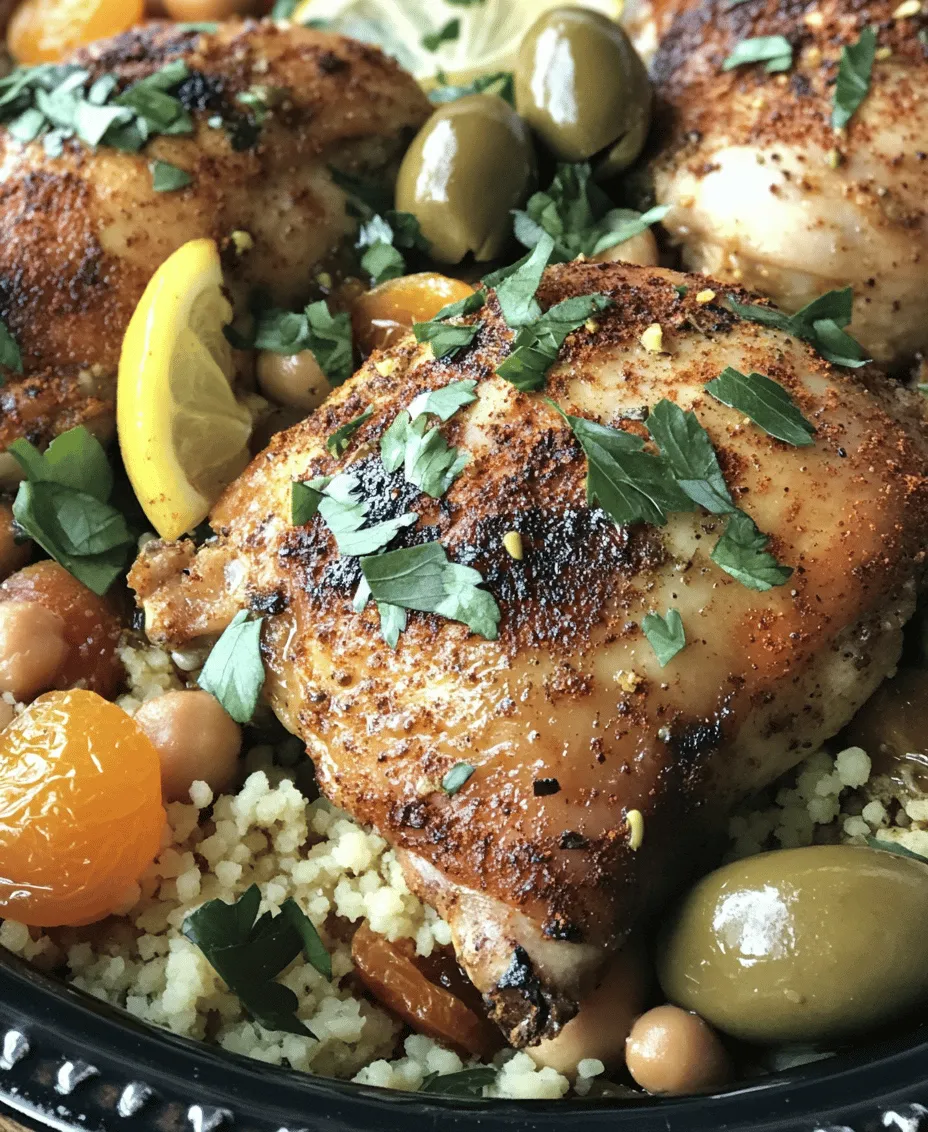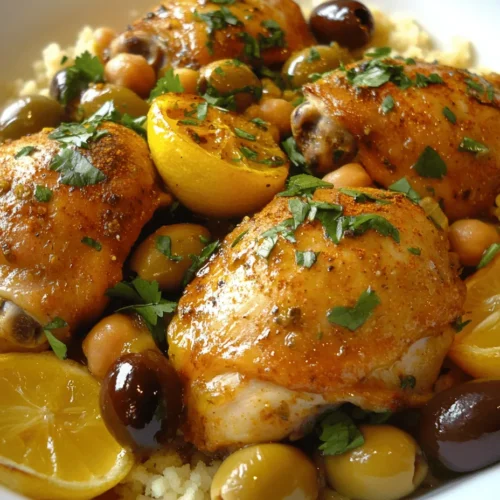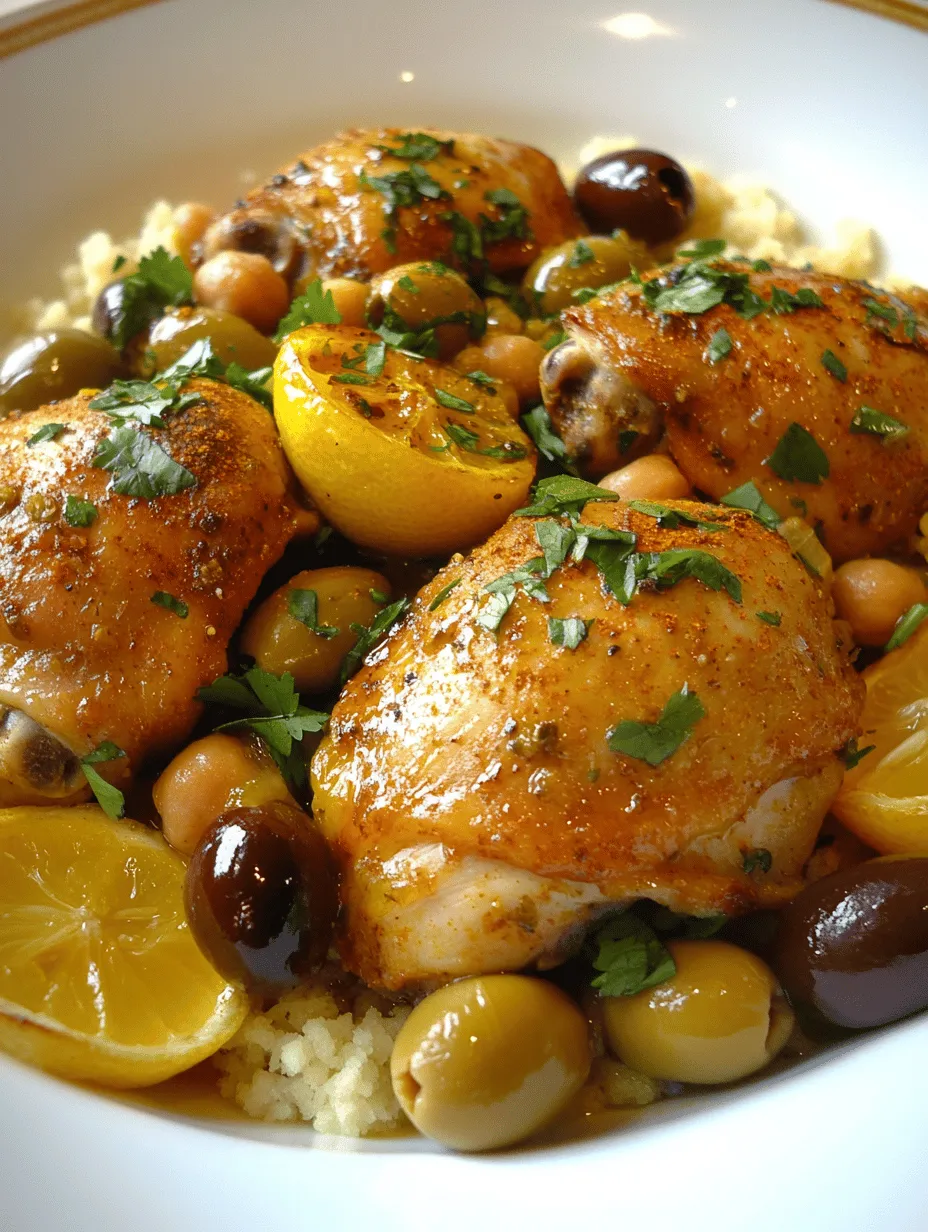Introduction
Embark on a culinary journey through the vibrant and aromatic world of Moroccan cuisine with our Zesty Chicken Tagine with Olives and Lemons. This flavorful dish is a staple in Moroccan households, reflecting the rich history and cultural diversity of the region. The origins of tagine cooking can be traced back centuries, rooted in the traditions of North African nomadic tribes who utilized the tagine pot for its efficiency in slow cooking. The unique combination of spices, preserved lemons, and tender chicken thighs creates a symphony of flavors that is both comforting and exotic.
Tagine, a traditional Moroccan cooking vessel, is not just a pot; it is an integral part of the culinary experience. The conical shape of the tagine allows steam to circulate, ensuring that the ingredients cook evenly while retaining moisture. This method of cooking not only helps in developing deep, complex flavors but also allows the ingredients to meld beautifully, creating a dish that is aromatic and succulent. The Zesty Chicken Tagine is a perfect representation of this cooking style, showcasing the interplay of spices, the brightness of preserved lemons, the brininess of olives, and the sweetness of dried fruits.
In this recipe, you will discover the importance of each ingredient that contributes to the dish’s unique profile. The zestiness of the lemons cuts through the richness of the chicken, while the olives provide a savory depth. The warm spices used in this dish, such as cumin, ginger, turmeric, cinnamon, and paprika, create an inviting aroma that will fill your kitchen. Join us as we delve into the art of tagine cooking and learn how to create this mouthwatering dish at home.
Understanding Tagine Cooking
At the heart of Moroccan cooking is the tagine, a traditional earthenware pot that has been used for centuries to prepare a variety of dishes. The tagine consists of two parts: a shallow, circular base and a conical lid. This design serves a functional purpose, allowing steam to rise and condense on the lid, which then drips back into the pot, keeping the food moist and tender. While tagines are often associated with Moroccan cuisine, they are also used in other North African countries, each with its variations and specialties.
One of the standout features of cooking in a tagine is the ability to slowly simmer ingredients, resulting in rich and complex flavors. The slow cooking process allows spices to bloom, and the natural juices of the ingredients meld together, creating a sauce that is both flavorful and aromatic. Cooking in a tagine or a heavy-bottomed pot ensures even heat distribution, reducing the risk of burning and allowing for a gentle cooking process that transforms tough cuts of meat into tender delights.
In addition to flavor enhancement, tagine cooking is also a health-conscious method. The slow simmering process requires less added fat, allowing the natural flavors of the ingredients to shine through. This method is particularly beneficial when using chicken thighs, as the slow cooking allows the meat to become tender and juicy without needing to rely on excessive oil. Overall, the tagine is a versatile cooking vessel that not only elevates the cooking process but also contributes to a communal dining experience, as meals are often served directly from the pot.
The Key Ingredients
A successful Zesty Chicken Tagine relies heavily on the quality and selection of ingredients used. Each component plays a vital role in creating the vibrant and complex flavors that characterize this dish. Here’s a closer look at the key ingredients that make this tagine truly special:
Chicken Thighs
When it comes to chicken tagine, bone-in, skin-on chicken thighs are the preferred choice. The bones add depth to the flavor and help keep the meat moist during cooking, while the skin renders fat, enriching the sauce. Chicken thighs are more forgiving than chicken breasts, which can dry out quickly, making them ideal for slow cooking methods like tagine.
Spices
Spices are the soul of Moroccan cuisine, and in this dish, a blend of cumin, ginger, turmeric, cinnamon, and paprika creates a warm and inviting aroma.
– Cumin adds a nutty, earthy flavor that enhances the overall complexity.
– Ginger provides a subtle heat and brightness that balances the richness of the chicken.
– Turmeric not only contributes a beautiful golden hue but also offers a warm, slightly bitter note.
– Cinnamon introduces sweetness and warmth, while
– Paprika lends a gentle smokiness and vibrant color.
Together, these spices create a well-rounded flavor profile that defines Moroccan tagine dishes.
Preserved Lemons
One of the standout ingredients in this recipe is preserved lemons. These lemons are cured in salt and their own juices, resulting in a tangy, salty flavor that is unique to Moroccan cuisine. The preserved lemons add a zesty brightness to the dish, cutting through the richness of the chicken and enhancing the overall flavor. They can be found in specialty grocery stores or made at home with just a few ingredients and some patience.
Olives and Dried Apricots
The addition of olives provides a briny contrast to the dish, balancing the flavors beautifully. Green olives, in particular, are commonly used in Moroccan cooking and add a savory depth to the tagine. Dried apricots add a touch of sweetness, complementing the spices and enhancing the overall flavor profile. The contrasting textures of the tender chicken, briny olives, and chewy apricots create a delightful eating experience.
Chickpeas
Chickpeas are another essential component of this dish, adding heartiness and nutritional benefits. They are an excellent source of protein and fiber, making the tagine more filling and satisfying. Additionally, chickpeas absorb the flavors of the spices and sauce, enhancing the dish’s overall taste.
Ingredient Substitutions
While this recipe calls for specific ingredients to achieve the authentic flavor of a Moroccan tagine, there are some substitutions you can consider if you cannot find certain items. For example, if preserved lemons are unavailable, you can substitute the zest and juice of fresh lemons, although the flavor will be less intense. If you prefer a different protein, lamb or beef can also be used, but note that cooking times may vary based on the cut and type of meat. For a vegetarian option, try using hearty vegetables such as eggplant, zucchini, or mushrooms in place of the chicken, along with vegetable broth for added flavor.
Preparation Steps
Now that you understand the importance of each ingredient, it’s time to break down the preparation process for the Zesty Chicken Tagine with Olives and Lemons. Each step is designed to maximize flavor and ensure a delicious outcome.
Seasoning the Chicken
Begin by seasoning the chicken thighs. This is an essential step in developing flavor, as marinating the chicken with spices allows the flavors to penetrate the meat. In a large bowl, combine the cumin, ginger, turmeric, cinnamon, paprika, salt, and pepper. Rub this spice mixture all over the chicken thighs, ensuring each piece is well-coated. For the best results, allow the chicken to marinate for at least 30 minutes, although a few hours or overnight in the refrigerator is ideal.
Searing
Once the chicken is marinated, it’s time to sear it. Heat a couple of tablespoons of olive oil in a tagine or heavy-bottomed pot over medium-high heat. Add the chicken thighs, skin-side down, and sear them for about 5-7 minutes until the skin is golden brown and crispy. This step not only adds flavor through browning but also helps to render some of the fat from the skin, which will contribute to the sauce’s richness. Once golden, flip the chicken and sear the other side for an additional 3-4 minutes. Remove the chicken from the pot and set it aside.
Sautéing Aromatics
With the chicken removed, it’s time to build the base flavor of the tagine. In the same pot, add diced onions and sauté them until they are translucent and fragrant, about 5 minutes. Next, add minced garlic and sauté for an additional minute, ensuring not to burn the garlic as it can become bitter. The sautéing process allows the aromatics to release their essential oils, creating a flavorful foundation for the dish.
Deglazing
After sautéing the aromatics, there will be bits of fond (the flavorful browned bits) stuck to the bottom of the pot. This is where the real flavor lies! To deglaze the pot, pour in a cup of chicken broth or water, scraping the bottom with a wooden spoon to lift those tasty morsels. This step is crucial, as it incorporates all the flavors into the sauce, enhancing the overall taste of the tagine. Once the fond is lifted, bring the mixture to a gentle simmer before returning the seared chicken thighs to the pot.
Final Preparations
Once the chicken is back in the pot, add the preserved lemons, olives, dried apricots, and chickpeas. Stir everything gently to combine, ensuring the chicken is nestled among the other ingredients. Cover the pot with the lid, reducing the heat to low, and let it simmer for about 45 minutes to an hour, or until the chicken is tender and fully cooked. The slow cooking process will allow the flavors to meld beautifully, resulting in a dish that is bursting with flavor.
As the tagine simmers, your kitchen will be filled with the enticing aroma of spices and cooked chicken, beckoning everyone to gather around the table. This Zesty Chicken Tagine with Olives and Lemons is not just a meal; it is a celebration of Moroccan flavors and a testament to the beauty of tagine cooking. Stay tuned as we continue this culinary adventure, exploring tips for best results and addressing common questions about this delectable dish.

Tips for Managing Timing and Temperature During Cooking
Cooking a Zesty Chicken Tagine with Olives and Lemons requires careful attention to timing and temperature to ensure that the flavors meld beautifully and the chicken remains tender. Here are some essential tips to help you manage these critical aspects:
Cooking the Tagine
Detailed Guide on the Simmering Process
Once you have combined all your ingredients in the tagine or pot, it’s time to bring the dish to life. Start by bringing the mixture to a gentle boil over medium heat. This initial phase helps activate the spices and infuse the oil with flavor. Once boiling, reduce the heat to low. The key to a successful tagine is simmering, which allows the chicken to cook slowly, absorbing all the aromatic flavors from the spices, olives, and preserved lemons.
Importance of Low Heat for Tender Chicken
Cooking on low heat is crucial for achieving tender, juicy chicken. High temperatures can cause the chicken to dry out and become tough. Instead, the slow simmer allows the meat to cook through evenly while remaining succulent. This gentle cooking method also encourages the spices to release their full potential, creating a rich and aromatic sauce that clings to the chicken.
How Often to Check and Adjust the Liquid Levels
During the cooking process, it’s essential to monitor the liquid levels in the tagine. Check every 10 to 15 minutes to ensure the sauce doesn’t evaporate completely. If you notice that the liquid is getting low, add a splash of chicken broth or water to maintain the desired consistency. The sauce should be thick yet pourable, and the chicken should be surrounded by a flavorful broth that complements the dish.
Discussion of the Final Cooking Steps and How to Achieve the Right Sauce Consistency
As your tagine simmers away, pay attention to the sauce’s consistency. In the last 10-15 minutes of cooking, you can remove the lid to let the sauce reduce slightly, allowing it to thicken naturally. This step intensifies the flavors and creates a luxurious texture that coats the chicken. If you prefer a thicker sauce, you can also mash a few pieces of the soft-cooked olives and lemons into the sauce to create a more velvety finish. Taste for seasoning, adding salt and pepper as needed before serving.
Serving Suggestions
Once your Zesty Chicken Tagine is ready, it’s time to think about how to serve it. This dish shines when paired with complementary sides and garnishes that enhance its vibrant flavors.
Ideal Accompaniments for the Zesty Chicken Tagine
The classic pairing for tagine is couscous, which acts as a perfect vehicle for the rich sauce. The fluffy grains soak up the savory broth, making every bite delightful. Alternatively, you can serve the tagine over steamed rice or quinoa, which also works well to balance the dish’s robust flavors.
Recommendations for Couscous or Rice Preparation
If you choose couscous, prepare it according to the package instructions, typically involving boiling water and letting the couscous steam for about 5 minutes. For added flavor, consider using chicken broth instead of water and toss in a bit of olive oil and a sprinkle of salt. If serving rice, opt for basmati or jasmine for a fragrant touch. Cook it with a bay leaf or a few cardamom pods for an aromatic experience that complements the tagine beautifully.
Suggested Garnishes and Their Visual and Flavor Contributions
Garnishing your dish takes it from simple to spectacular. Fresh herbs like cilantro or parsley add a pop of color and a burst of freshness that contrast beautifully with the rich flavors of the tagine. Additionally, toasted almonds or pine nuts can provide a delightful crunch. For an extra zing, serve lemon wedges on the side, allowing guests to squeeze fresh juice over their portions for a bright finish.
Creating a Complete Meal Experience with Sides and Beverages
To create a cohesive meal experience, consider serving a light salad, such as a tabbouleh or a mixed greens salad dressed with a citrus vinaigrette. These salads provide a refreshing balance to the richness of the tagine. For beverages, traditional Moroccan mint tea is a perfect match, or you could opt for a light white wine like a Sauvignon Blanc that complements the dish’s flavors without overpowering them.
Nutritional Information
Understanding the nutritional value of your Zesty Chicken Tagine can be beneficial for those keeping an eye on their dietary intake.
Breakdown of the Nutritional Value of the Dish Per Serving
While the exact nutritional content can vary based on portion size and specific ingredients used, a typical serving of Zesty Chicken Tagine (approximately 1 cup) may contain:
– Calories: 350-400 kcal
– Protein: 30g
– Carbohydrates: 20g
– Fat: 15g
– Fiber: 3g
Health Benefits of the Key Ingredients
This dish boasts several health benefits thanks to its wholesome ingredients. Chicken is a lean protein source, essential for muscle repair and growth. Olives provide heart-healthy fats and antioxidants, while lemons are rich in vitamin C, supporting immune function. Spices like cumin and coriander are known for their anti-inflammatory properties, enhancing the dish’s health profile.
Discussion of Portion Sizes and Dietary Considerations
When serving Zesty Chicken Tagine, consider portion sizes based on your guests’ dietary needs. For a heartier meal, serve with generous portions of couscous or rice. If you’re catering to lighter appetites or dietary restrictions, smaller servings with ample vegetables can suffice. This recipe can easily be adapted for gluten-free diets by substituting couscous with quinoa or cauliflower rice.
Cultural Significance and Variations
Exploring the cultural significance of tagine dishes adds depth to your culinary experience.
Exploration of the Cultural Background of Tagine Dishes in Morocco
Tagine is more than just a cooking method; it represents a fundamental aspect of Moroccan culture. Traditionally, it refers to both the earthenware pot and the dish prepared within it. The slow-cooked meals often symbolize hospitality and sharing, making their way to communal dining tables during family gatherings and celebrations. The combination of spices in a tagine reflects Morocco’s rich trade history, showcasing influences from various cultures.
Variations of the Recipe Across Different Regions or Families
While the Zesty Chicken Tagine with Olives and Lemons is a delightful classic, variations abound across Morocco. In some regions, you might find tagines featuring lamb or beef, while others may incorporate dried fruits like apricots or raisins for a sweet twist. Families often add their unique touches, such as local herbs or spices, making each tagine a personal expression of culinary heritage.
How to Incorporate Personal Touches or Local Ingredients
Feel free to experiment with the recipe by incorporating local ingredients or flavors that resonate with your palate. Consider adding preserved lemons if they are available, or try using different types of olives for varied taste profiles. Spices can also be adjusted; for a spicier kick, add harissa or a pinch of cayenne pepper. Embrace creativity and make this dish your own.
Conclusion
The Zesty Chicken Tagine with Olives and Lemons is a celebration of flavors, textures, and culinary tradition that invites you to explore the wonders of Moroccan cuisine. The combination of tender chicken, aromatic spices, and vibrant olives creates a dish that is both comforting and exotic, perfect for sharing with friends and family.
As you savor each bite, remember that cooking and sharing a tagine is about more than just the meal; it’s about the experience of coming together, enjoying the process, and creating lasting memories. So gather around your table, serve this delightful dish, and immerse yourself in the communal spirit that tagine meals embody. By trying this recipe, you not only indulge in a delicious meal but also take a step into a rich culinary tradition that spans generations. Enjoy the journey!



